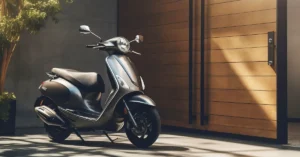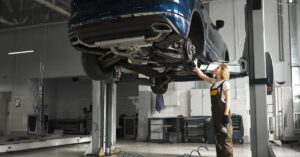Tata Motors on Tuesday marked the culmination of a multi-year corporate reshuffle that splits the century-old automaker into two separately listed companies – one focused on commercial vehicles (CV) and the other on passenger vehicles (PV), electric mobility and Jaguar Land Rover (JLR). The move, the company and analysts say, is aimed at unlocking shareholder value, clarifying strategic priorities and giving each business the operational freedom to pursue its own product, technology and capital plans.
What changed, and why it matters?
Under the scheme approved by the Tata Motors board in March 2024 and cleared by shareholders earlier this year, Tata Motors’ commercial-vehicle operations and related investments have been carved out into a separate listed company, while the passenger-vehicle, electric vehicle and JLR businesses remain together in the other listed entity. The company says the split reflects that “there are limited synergies between Commercial Vehicles (CV) and Passenger Vehicles (PV) businesses” while there are “considerable synergies to be harnessed across PV, EV and JLR,” especially around electrification, software and advanced vehicle platforms.
Key facts
- The demerger was approved by shareholders in May 2025, with the proposal passing overwhelmingly – “approved with 99.9995% of votes,” according to the company’s exchange filing.
- The formal entitlement was structured on a 1:1 basis: “Share entitlement ratio will be 1:1, i.e., the shareholders of Tata Motors Ltd will have an identical shareholding in both the listed entities.”
- Tata’s newly separated commercial-vehicle arm is scheduled to debut on India’s stock exchanges on November 12, 2025, completing the final legal and market steps of the restructuring.
Company rationale
Tata Motors’ chairman N. Chandrasekaran framed the split as a move to accelerate growth and accountability. In the company release he said:
“Tata Motors has scripted a strong turnaround in the last few years. The three automotive business units are now operating independently and delivering consistent performance. This demerger will help them better capitalise on the opportunities provided by the market by enhancing their focus and agility. This will lead to a superior experience for our customers, better growth prospects for our employees and, enhanced value for our shareholders.”
On timing and approvals the company warned that the formal NCLT scheme “shall be placed before the TML Board of Directors for approval in the coming months and will be subject to all necessary shareholder, creditor and regulatory approvals which could take a further 12-15 months to complete.” That clarification, included in Tata’s release, reflected the phased legal steps the group has followed since the March 2024 board decision.
What the market sees – value unlocking and clearer comparables
Analysts and brokers widely called the move a value-unlock: separating a capital-intensive, cyclical commercial vehicle business from an EV-and-luxury oriented passenger vehicle business (which includes JLR) makes it easier for investors to value each franchise on its own merits. Brokers cited in coverage have published differing fair-value ranges for the two stocks, and early market reaction in pre-listing price signals pointed to a re-rating of both businesses. The Economic Times noted the split’s effect on stock pricing and that the CV company will initially be in the trade-for-trade segment for the first 10 sessions.
Strategic context: globalization, JLR and the Iveco acquisition
The demerger comes as Tata Motors pursues parallel moves to build scale in commercial vehicles globally – notably the proposed acquisition of Italy’s Iveco truck and bus business, which Tata says would expand its footprint in Europe and bring new technology and scale to the CV business. Market observers see the Iveco deal and the demerger as complementary: one creates a clearer, more investible CV platform; the other adds international volume, technology and market access.
Leadership and governance changes
As part of the corporate redesign, Tata has publicly signalled new leadership roles tailored to the two businesses. Senior Tata executives and handpicked leaders with domain experience will head the separate entities – a governance step intended to give each company tailored boards, management teams and strategic autonomy. Media reports and filings detail appointments and transition timetables that align with the demerger and subsequent listings.
What shareholders and customers should watch next
- Listing performance and early flows: The CV arm’s listing on November 12 will be the first market test of investor appetite for the standalone CV thesis. Expect heightened volatility during the initial trade-for-trade session window.
- Regulatory and legal milestones: Although the boards have approved the scheme and shareholders have voted, several formal approvals – creditors, NCLT filings and exchange formalities remain part of the legal playbook. The company itself said the process “could take a further 12-15 months to complete.”
- Iveco integration and capital plans: Any material update on the Iveco acquisition (including regulatory sign-offs and integration financing) will materially affect the CV arm’s strategic trajectory and valuation.
Editor’s Note
The Tata Motors demerger is one of India’s largest corporate reorganizations in the auto sector in recent years. By separating cyclical commercial operations from the higher-growth passenger and electric mobility business (plus JLR), Tata aims to create two clearer investment stories and dedicated managerial focus. For investors, the immediate signals will come from listing market reaction, analysts’ re-ratings and how Tata funds any global acquisitions that accelerate scale in the CV business.
ⓘ As part of our ongoing support for startups and SMEs, LAFFAZ Media publishes feature and resource articles that may include references and links to external websites. These inclusions are selected at our editorial discretion to provide valuable information to our readers. LAFFAZ Media does not control, endorse, or assume responsibility for the content or practices of external websites. For more details, please refer to our Terms and Conditions.






